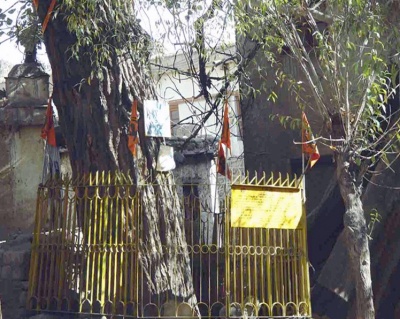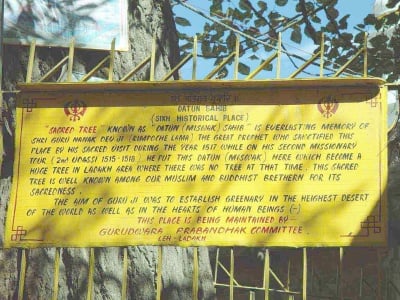Datun Sahib: Difference between revisions
Allenwalla (talk | contribs) mNo edit summary |
Allenwalla (talk | contribs) mNo edit summary |
||
| Line 1: | Line 1: | ||
[[Image:Datun_Sahib_2_Leh_Ladhakh_copy.jpg|thumb|400px|right]] | [[Image:Datun_Sahib_2_Leh_Ladhakh_copy.jpg|thumb|400px|right]] | ||
In Leh City there is an ancient 'Sacred' Datun, well known around the city as Datun (Miswak) Sahib, tree which many people believe is the biggest and oldest tree tree actually planted by Guru Nanak Dev ji during his travels. Considered to be sacred by the cities residents reguardless of their religion the tree was the first to grow in the area. At the time of the Guru's visit the high desert had no trees as only small | In Leh City there is an ancient 'Sacred' Datun, well known around the city as Datun (Miswak) Sahib, tree which many people believe is the biggest and oldest tree tree actually planted by Guru Nanak Dev ji during his travels. Considered to be sacred by the cities residents reguardless of their religion the tree was the first to grow in the area. At the time of the Guru's visit the high desert had no trees as only small shrubs and bushes would grow at the high, arid altitude. The Guru's sapling has grown to be the biggest tree in the city. | ||
Thought to have been planted by Guru Nanak on his second missionary tour (Udassi 1515-18) the venerated tree is located in the city's main bazar at the rear of its main mosque. A board relating the history of the Guru's visit and his planting of the young neem tree has been erected on a fence, which encircles the tree. Along with the fence and signboard a Nishan Sahib has been erected by the Sikh Sangat. Though the sign states that the Gurdwara Prabandak Committee of Leh-Ladak is maintaining the site, the tree is in need of immediate maintainence as its condition is deteriorating daily. | Thought to have been planted by Guru Nanak on his second missionary tour (Udassi 1515-18) the venerated tree is located in the city's main bazar at the rear of its main mosque. A board relating the history of the Guru's visit and his planting of the young neem tree has been erected on a fence, which encircles the tree. Along with the fence and signboard a Nishan Sahib has been erected by the Sikh Sangat. Though the sign states that the Gurdwara Prabandak Committee of Leh-Ladak is maintaining the site, the tree is in need of immediate maintainence as its condition is deteriorating daily. | ||
Revision as of 22:42, 25 July 2008
In Leh City there is an ancient 'Sacred' Datun, well known around the city as Datun (Miswak) Sahib, tree which many people believe is the biggest and oldest tree tree actually planted by Guru Nanak Dev ji during his travels. Considered to be sacred by the cities residents reguardless of their religion the tree was the first to grow in the area. At the time of the Guru's visit the high desert had no trees as only small shrubs and bushes would grow at the high, arid altitude. The Guru's sapling has grown to be the biggest tree in the city.
Thought to have been planted by Guru Nanak on his second missionary tour (Udassi 1515-18) the venerated tree is located in the city's main bazar at the rear of its main mosque. A board relating the history of the Guru's visit and his planting of the young neem tree has been erected on a fence, which encircles the tree. Along with the fence and signboard a Nishan Sahib has been erected by the Sikh Sangat. Though the sign states that the Gurdwara Prabandak Committee of Leh-Ladak is maintaining the site, the tree is in need of immediate maintainence as its condition is deteriorating daily.
In India the Datun has often been referred to as the 'village pharmacy'; its antibiotic and germ killing abilities have long been known in Aruvedic medicine. The people of India have long revered the tree, as daily millions use neem twigs to clean their teeth. One of India's richest men has built a fortune in no small part on his business of using the tree's sap as a natural insecticide for Agricultural use.
See also:


